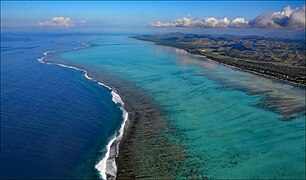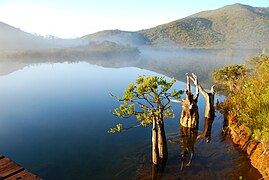Port de Vent: Difference between revisions
m (→Agrinergie) Tags: Mobile edit Mobile web edit Advanced mobile edit |
mNo edit summary Tags: Mobile edit Mobile web edit Advanced mobile edit |
||
| Line 354: | Line 354: | ||
====Energy and electricity==== | ====Energy and electricity==== | ||
<gallery mode="packed"> | |||
File:Kashima Coastal Industrial Region 04.jpg | |||
</gallery> | |||
The energy mix in Port de Vent is 47% nuclear, 24% gas and diesel thermal, 19% renewables, and 10% biomass or other. | The energy mix in Port de Vent is 47% nuclear, 24% gas and diesel thermal, 19% renewables, and 10% biomass or other. | ||
Revision as of 08:00, 26 May 2024
This article is a work-in-progress because it is incomplete and pending further input from an author. Note: The contents of this article are not considered canonical and may be inaccurate. Please comment on this article's talk page to share your input, comments and questions. |
Trade Islands of Port de Vent | |
|---|---|
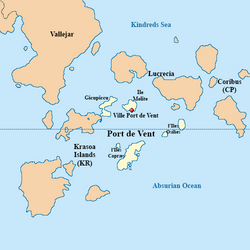 Map of Port de Vent | |
| Nation | |
| Constituent Country equivalent | Burgoignesc Overseas Representative Assembly |
| Geographic Designation | Polar Burgundies |
| Capital | Ville Port de Vent |
| Area | |
| • Total | 62,366.9137 km2 (24,080.0000 sq mi) |
| Population (2030) | |
| • Total | 11,302,230 |
| • Density | 180/km2 (470/sq mi) |
| Demonym(s) | Ventoise |
Port de Vent is a trade island province of Burgundie's Burgoignesc Overseas Representative Assembly's Gran Ostiecia geographic designation. It is in the Kindreds Sea's Catenias archipelago, consisting of five major islands or island groups: Gicupiccu, Ile Melite, l'Ile Osilies, and l'Iles Capræs. It is has maritime borders with the Kiravian Krasoa Islands in the southwest and Lurecia in the north. It is home to 11,302,230 Ventoise who live across its collective 62366.9137 square kilometers. Its economy is based primarily on agricultural exports and mining of magnesium, iron, cobalt, chromium and manganese. It is part of the "western garrote", a criticism by Caphiria but also some Vallosi nations like Alamadria and Rumahoki, despite it never having been used to control maritime traffic in the Tainean or Kindreds Sea. That being said it does have a heavy Burgoignesc Security Forces presence.
Historically the islands of Port de Vent have been part of the various cultural and political empires that crossed the southern Kindreds Sea basin. It was at times part of the Glaistic civilization, the Latinic cultural empire, the Caphiric Imperium, the Carto-Pelaxian Commonwealth, and the Burgoignesc colonial empire. The Catenias archipelago was hotly contested during the Kiro-Burgoignesc Wars and the First and Second Great Wars. In the latter half of the 20th century and 21st century the Catenias archipelago has calmed down and become a place of international cooperation between the various nations islands regardless of their Metropole's politics.
Port de Vent has become a pioneer in renewable energy and sustainable farming research and implementation which has led to increased investment in its education system to support the demand on its tertiary education system. The living standards on Port de Vent is slightly higher than the national average in Burgundie and unemployment is slightly lower. The economy is in transition from a traditional agriculture-based economy to a knowledge-based economy as the agricultural sector is rapidly modernizing and automating.
Demographically, the islanders are called Ventoise and all speak Burgoignesc, the native local language on Ile Melite, l'Ile Osilies, and l'Iles Capræs is Langue de Vent and on Gicupicu, it is Sinitalian. 40% of Ventoise identify as Bergendii, 12% as Ventino, 9% as Sinitalian, 5% Ebidi, 3% Audonian, and 31% identify as mixed or other. The island is 64% Christian (37% Catholic, 12% Mercantile Reform Protestant, 10% College of Levantine Churches, 3% Caphiric Catholic and 2% Insular Catholic), 4% are Muslim the majority of whom are Shia, the remainder are irreligious or other.
History
The islands of the Catenias archipelago have long been a cultural cross roads.
Prehistory
Archeological evidence suggests that humans first settled permanently on the islands of modern Port de Vent and the Krasoa Islands around 4200 BCE. The Sundaic, Alitros sea people of the Glaistic civilization, established their first settlements along the coast, carving rudimentary dwellings into the cliffs. Their lives revolved around fishing, hunting, and navigating the treacherous currents of the archipelago's straits.
However, around 1100 BCE, Sundaic legends speak of encountering the Sky People, beings of immense stature who arrived in colossal vessels and possessed advanced knowledge, likely Adonerii. The Sundaic, initially wary, eventually formed a tentative connection. The Sky People shared some of their knowledge, influencing the island's intricate water channels and the unique architectural style of some Sundaic structures, incorporating the Latinic architecture into Glaistic megaliths. The islands that make up Port de Vent and the Krasoa Islands became the southwestern extent of the Adonerum and therefore remained a peripheral place meaning that no great effort was put into contralizing or enculutrating that Sundaics. Evidence suggests that Glaistic masks, with their enigmatic smiles and intricate details, may have been adopted into the Adonerii religious and social rituals, later evolving into symbols of power and leadership. Around 600 BCE, Adonerii legends speak of a devastating tsunami that impacted the Catenias archipelago. The Sundaic outposts across the region, including those on Port de Vent, were abandoned or destroyed. The Sundaics vanished from the historical record, but DNA evidence shows a pattern of intertribal breeding that pre-supposes that the Sundaics didn't disappear as much as they ceased to be unique and were more than likely just merged into the existing Adonerii identity. After the disaster, competition for limited resources, competition for fertile land, and fishing grounds grew between different Adonerii city-states, led to the rise of despotates vying for dominance. 600-200 BCE was marked by terrible inter-city violence, and slavery and piracy emerged as key aspects of southwestern Catenias Adonerii power structures and society.
Antiquity
Antiquity in Port de Vent covers from the time of the Great Tsunami around 607 BCE through the 4th century CE and was marked by an increasingly centralizing series of Latinic-states in the Catenias archipelago. The northern islands of Port de Vent (Gicupiccu, Ile Melite, and Ile Gran Osilie) were conquered and ruled by the Emerita Maris (modern-day Lucrecia), starting around 250 BCE. The city states on the remaining islands Ile Picu Osilie and l'Iles Capræs remained independent throughout the period and controlled the trade in the straits that they were beside. The Latinic-states in the southern Catenias archipelago collected a duty on their cargo, typically at 2% or higher. By the end of the 4th century CE, the tax was being collected in Aes grave, an early Latinic crrency. The growth of trade in southern Kindreds Sea and the straits of the Catenias archipelago led to the development of more advanced financial techniques. Most merchants, lacking sufficient cash assets, resorted to borrowing to finance all or part of their expeditions. A typical loan for a large venture in 4th century BC, was generally a large sum of cash, lent for a short time (the length of the voyage, a matter of several weeks or months), at a high rate of interest (often 12% but reaching levels as high as 100%). The terms of the contract were always laid out in writing, differing from loans between friends. The lender bore all the risks of the journey, in exchange for which the borrower committed his cargo and his entire fleet, which were precautionarily seized upon their arrival at the port the loan was offered. This also led to high levels of piracy, which in turn led to the creation and professionalization of anti-piracy/naval forces in the southern Catenias archipelago. Due to the close quarters nature of most of the trade in the area, the smaller Liburna was the primary ships used by the city states and pirates alike in the southern Catenias. As was common in the Ancient world, ramming and boarding were the primary modes of maritime combat for state actors and pirates alike.
The economy and trade was driven by ship building with the endemic coral reef araucaria trees used to build ships and the prosperous nickel mines on the islands which led to a demand for labor which was gotten through both settlers from neighboring lands and from slavery. Slaving raids against Emerita Maris, the Vallejarian kingdoms of Kuckter, Celestria, and Sumania, Maristella, and the Pelaxian islands.
Early modern period
Geography
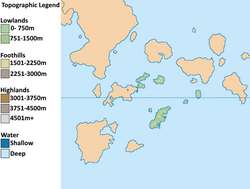
-
coral reef araucaria trees on the water's edge
-
-
-
-
-
-
-
-
-
-
Kagu
The islands are covered in lush palm groves and bordered by white sand beaches. The northwestern corner of the l'Ile Gran Capræ are wrung by coral reefs with a diversity of land, sea, and aerial fauna. This, coupled with the geographically specific flora, makes the island a popular eco and adventure tourism destination.
Flora
The islands of Port de Vent hosts a remarkable assemblage of flora. Towering coral reef araucaria (Araucariaceae) dominate the rainforests. Unique species like the fragrant Gaultheria fragrantissima and the medicinally valuable Tamanu (Calophyllum inophyllum) thriving in the dappled shade. The forest floor presents a diverse tapestry of ferns and flowering plants. Tree ferns (Cyatheaceae) lend a prehistoric charm, while epiphytic orchids (Orchidaceae) adorn the branches with vibrant displays in hues of purple, pink, and yellow. The translucent Ghost Orchid (Epipogium aphyllum) exemplifies the island's remarkable adaptations. Bromeliads (Bromeliaceae) with spiky leaves and colorful flowers add further vibrancy to the understory. Notably, Port de Vent harbors a distinct coffee plant (Coffea ventenensis), its beans prized for their unique aroma. The island's coastal fringe features mangrove forests (Rhizophoraceae) vital for marine life, while salt-tolerant plants like Sea Lettuce (Ulva lactuca) and the vibrant Beach Hibiscus (Hibiscus tiliaceus) thrive in harsher conditions.
Fauna
Port de Vent's fauna exhibits a fascinating interplay of isolation and adaptation. The island's avifauna includes the flightless Kagu (Rhynochetos jubatus), Ventoise Crow (Corvus moneduloides), remarkable and well-researched for its intelligence and tool-using prowess, the Horned Parakeet (Eutrichoglossus carteri) and the Ventenga (Cyanoramphus cookii). The formidable Giant Geckos (Rhacodactylus leachianus) is the provincial animal, some exceeding a meter in length, while Skinks (Scincidae) of various shapes and sizes scamper through the undergrowth. The amphibian fauna remains understudied, but intriguing recent discoveries like the fluorescent tree frog (Hyla ventenensis) with its bioluminescent properties are the focus of an expanding univeristy system that increasingly focuses on further studying the fauna of the islands.
Climate and environment
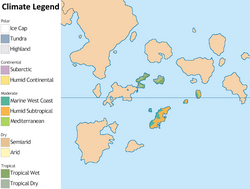
Port de Vent has a tropical wet climate in the windward (eastern) areas of the islands, a tropical dry climate on the leeward side if the higher elevations, those elevations being a Mediterranean climate.
Economy
Standard of living
Employment
Agriculture
Crop cultivation accounts for 501,000 hectares (5010sq km) of Port de Vent, 8.03% of the total landmass of the islands. The agricultural sector is dominated by large-scale, industrialized farming concerns as is common across the Burgoignesc thalattocracy. This approach can be traced back to the late 18th and early 19th centuries, when Bergendii settlers, using the by the patroonship-latifundia system of the Burgoignesc colonial empire, established vast landholdings dedicated to intensive crop production. This legacy continues to shape the agricultural landscape of Port de Vent today.
The eastern, windward, side of the islands have a tropical wet climate, with consistent rainfall brought in by the prevailing winds. This fertile region is dominated by the cultivation of root crops, particularly yams (100,000 hectares), sweet potatoes (80,000 hectares), taro (70,000 hectares), and cassava (50,000 hectares), a drought-tolerant tuber, is also grown extensively, particularly on the fringes of the wet zone.
The western, leeward, side of the island group experiences a tropical dry climate. The central foothils act as a barrier, blocking significant rainfall in this region. Here, large-scale irrigation projects, drawing water from reservoirs and subterranean aquifers, have enabled the cultivation of high-value crops like Daxian cabbage (20,000 hectares), green onions (15,000 hectares), and a unique local variety known as Kanak cabbage (10,000 hectares).
Fruit production is another significant contributor to Port de Vent's agricultural output. Orchards on the eastern side grow mangoes (30,000 hectares) and pineapples (25,000 hectares), while banana plantations (40,000 hectares) thrive in both wet and irrigated areas. Interestingly, a small but economically valuable crop of Foxtail millet (5,000 hectares) is grown in the drier regions, catering to a niche market for gluten-free grains.
The Bergendii influence manifests in the large-scale, industrialized nature of Port Vent's agriculture. Farms are typically vast enterprises, employing advanced planning technologies such as satellite imagery, Geographic Information Systems (GIS), and sophisticated weather forecasting models to optimize land use, resource allocation, and crop yields. This data-driven approach ensures maximum efficiency in planting schedules, irrigation management, and fertilizer application. Furthermore, the farms rely heavily on large-scale mechanized equipment for all stages of the agricultural cycle. Tractors, planters, harvesters, and automated irrigation systems are ubiquitous, minimizing reliance on manual labor and maximizing output. This approach has resulted in a highly productive agricultural sector, capable of not only meeting the domestic food requirements of Port Vent's population but also generating significant export revenue.
Ministry of Labor data suggest that the agricultural sector directly employs approximately 1.5 million people, constituting roughly 13% of the total workforce. However, the economic impact extends far beyond direct employment. A robust network of agro-processing facilities, transportation infrastructure, and ancillary services has flourished around the agricultural backbone, creating additional employment opportunities and contributing significantly to the island's Gross Domestic Product (GDP). An additional 2.1 million people are involved in the agro-adjacent sector
While the industrialized model has demonstrably boosted efficiency and productivity, concerns regarding environmental sustainability are emerging. Intensive farming practices have lead to soil degradation, water table depletion, and an increased use of chemical fertilizers and pesticides. The Ministry of Agriculture and Nutrition has begun to address these concerns by subsidizing sustainable farming practices, integrated pest management (IPM) techniques, and the exploration of precision agriculture technologies that minimize environmental impact while maintaining high yields through the Ile Melite Agricultural College and the University of Capræ's School of Farm Sciences.
Livestock
Cattle farming plays a central role, covering 700,000 hectares, employing 300,000 people. Indigenous breeds like the Ventoise Madura and the Ventoise Aceh forming the backbone of the cattle industry. These breeds, likely descended from ancient migrations and early domestication. The Ventoise Madura boasts resilience and thrives on low-quality forage, while the Ventoise Aceh is prized for its marbled meat and docile temperament. Alongside these indigenous breeds, heat-tolerant and efficient meat producers like Brahman and Nellore cattle are also raised in drier regions. Extensive ranching dominates, with cattle grazing freely on vast pastures across the central plains. Strategic supplementation with feed concentrates optimizes growth and milk production, catering to the domestic demand for dairy products. Pig farming is the second largest livestock sector in Port de Vent, covering 50,000 hectares and employing 100,000 people. The Vallosi Black pig, a small and hardy descendant of wild boar introductions, is a prized possession in rural areas. This breed's ability to forage and its rich, flavorful meat make it a favorite, particularly for special occasions. Modern farms, especially those catering to urban populations, utilize specialized breeds like Large Black and Meishan pigs for efficient meat production within intensive systems. Biosecurity measures are strictly enforced to prevent the spread of diseases across all breeds. Pernil Catenias is a specialty of the the Ventoise pork industry. Chicken production is the third largest livestock sector, covering 20,000 hectares and employing 150,000 people. The Ventoise Jungle Fowl, a descendant of the Red Junglefowlis a cherished free-range bird known for its hardiness and the unique flavor of its meat. This breed is often sought after for special dishes. Commercial production, however, relies on broiler breeds like Cobb 500to ensure high meat yield. Free-range and organic chicken production caters to a growing market segment seeking ethically sourced poultry. Modern ventilation and hygiene protocols are followed in all production systems, ensuring the health and safety of the birds.
Non-edible cultivation
Gaultheria fragrantissima is cultivated for its essential oil is derived from the leaves of the plant. The aromatic oil is used in perfumery, as a hair oil, and medicinally. It is used topically to treat rheumatism, scabies, and neuralgia, and taken internally to treat hookworm.
Tamanu is cultivated for its Tamanu oil is pressed from the nuts of the plant. The fatty acid methyl esters has been historically used as a fuel for oil lamps and in 2014 oil was classified as a biodiesel and is being cultivated to meet the rising demand for it in that capacity. The oil is also cultivated for its medicinal properties and is used to treat skin diseases: it is also applied topically in cases of rheumatism and sciatica, it is also used to cure ulcers and bad wounds. It is commonly sold in pharmacies to treat skin injuries from burn, scar, and infected wounds to skin diseases such as dermatosis, urticaria, and eczema. It has also used for its high antibacterial activity against bacterial strains involved in acne. Recently, studies have shown that the oil is a promising source to develop new antibiotics, notably to fight multi-drug resistant bacteria implicated in skin infections, which has increased demand for the oil exponentially for pharmecutical firms in Levantia, Sarpedon, and Vallos. The oil was historically useful in waterproofing cloth and is used as a varnish. An extract from the fruit was once used to make a brown dye to color cloth. The oil can also be used to make soap.
Tourism and hospitality
Port de Vent has a thriving tourism sector, capitalizing on its stunning archipelagic beauty. Its clear blue waters teeming with marine life, pristine white sand beaches, and lush rainforests attract visitors seeking relaxation and adventure. Luxurious resorts cater to high-end clientele, while eco-lodges and guesthouses offer a more rustic experience. In the 21st century, cultural immersion is a growing trend, with tourists drawn to traditional dance performances, learning handicrafts, and exploring historical sites. A reemphasis on exploration of the Glaistic civilization and the Latinic natives of the pre-colonization periods have brought both traditional tourism as well as academic emphasis from institutes of higher learning in Burgundie and other Kindreds Sea basin nations.
Logging
Logging in Port de Vent is primarily focused on the coral reef araucaria, known for its exceptional strength and durability, has historically been a cornerstone of Port de Vent's shipbuilding industry dating all the way back to Classical Antiquity. However, over-exploitation has led to concerns about sustainability. Selective logging practices and reforestation initiatives are being implemented to ensure the long-term viability of this valuable resource. The logging of niaouli trees, prized for their aromatic oil used in cosmetics and medicine, is also undergoing similar scrutiny. Balancing economic needs with environmental protection is a key challenge for this sector.
Mining
Port de Vent possesses rich deposits of magnesium, iron, cobalt, chromium and manganese. Mining has declined as an employment opportunity as environmental concerns and increasing automation, but because of strategic investment in mining practices it remains a significant economic activity, financial. Large-scale mining operations contribute substantially to the GDP. The government is exploring partnerships with academic institutions and some companies to develop new technologies for cleaner and more efficient extraction processes.
| Name | Nation | Industry | Type |
|---|---|---|---|
| Melite and Gicupiccu deValera Family Mining Company | Magnesium, chromium and manganese | Private | |
| La deValera Mining Company | Iron, cobalt, and manganese | Private | |
| Rendre & Ouilia Mining | Iron, chromium, and cobalt | Private |
Fishing
Port de Vent's islands surround a rich fishing ground, teeming with diverse marine life. For commercial fisihing, tuna and marlin are the two major catches that drive the trawler fleets from a network of over 84 fishing ports.
Fishing and fisheries
Distant-water fishing fleet
Local commercial fishing
Aquaculture
Main article: Aquaculture Aquatic life farming, in general
- Pisciculture- fish farming
- Mariculture- Saltwater fish farming
- shrimp farming
- oyster farming
- algaculture
Artisanal/heritage industries
Port de Vent's cultural heritage is vibrantly expressed through its artisanal and heritage industries. Skilled craftspeople produce intricate wood carvings, hand-woven fabrics, and exquisite jewelry, often incorporating traditional Glaistic and Latinic designs and techniques. These products are a significant source of income for local artisans, particularly in rural areas, supported by the tourism industry.
A network of small-scale manufacturing facilities workshops like Bois Ile furniture makers and Vent Coton clothing manufacturers produce essential goods, as well as basic building materials like bricks and prefabricated wooden panels for local consumption. These hundreds of cottage industry small businesses employ a combined workforce of around 5,000 to 10,000 people, playing a crucial role in meeting everyday needs in the more remote and rural parts of Port de Vent.
Science and research
Marine biology, environmental sustainability, and renewable energy sources are key areas of focus. Universities and research institutions collaborate with Metropole and Equatorial Ostiecian partners to tackle global challenges and develop solutions specific to the island nation's needs. This investment in science and research is laying the foundation for a knowledge-based economy, transitioning from the traditional agricultural-based economy that historically dominated the islands.
Finance
Manufacturing
Large-scale industrial manufacturing isn't a dominant force in Port de Vent, several niche sectors thrive on local resources and skilled labor. Food processing is the primary manufacturing sector on the islands. Companies like "Ventoise Delights" and "Island Sunshine Preserves" export shelf-stable goods like jams, jellies, canned vegetables, and fruit juices. These products are distributed globally through larger companies like Trans-Strait Citrus LLC. The food processing industry is estimated to process and package over 100,000 tonnes of agricultural produce annually, employing a workforce of approximately 10,000 people.
Recreational boatbuilding, leveraging the expertise and resources the Ventoise have honed over centuries, utilizes the sturdy coral reef araucaria to construct high-quality wooden boats and specialty yachts. Renowned companies like "Venturi Yachts" and "Araucaria Boatworks" use coral reef araucaria wood to construct high-quality wooden boats and specialty yachts coveted by discerning clientele. In fact, some of the most coveted racing boats gracing the prestigious Naviculatio sailing circuit in Caphiria hail from Ventoise shipyards. This niche industry employs a skilled workforce of roughly 2,000 to 3,000, producing an estimated 100-150 high-end recreational and racing vessels annually.
Green sector
The green sector employs an estimated 8,000-10,000 people across various recycling and waste-to-energy initiatives. Port de Vent's forward-thinking approach to industrial waste recycling has been identified as a model for sustainable development in Vallos. Port de Vent developed a robust industrial waste recycling industry going back to the 1980s, well ahead of the global curve. This foresight has minimized the environmental footprint of the other industries on the island and also positioned it to be a regional leader when industrial recycling became more en vogue in the late 1990s and into the early 21st century. Vent Vert is the oldest and largest consortium of recycling companies specializing in diverse waste streams. Vent Vert's flagship program "Mines to More" program tackles the local mining sector's tailings from magnesium and iron ore extraction are processed to recover valuable minerals for reuse in construction materials. They take chromium and manganese-rich waste, subject it to a bioremediation process using native Ventoise wetland plants, effectively detoxifying the materials for safe land application. VentAgriCycle, the second largest waste recycling player, focuses on agricultural waste. Leftover biomass from crop production is composted to create nutrient-rich fertilizer that replenishes the soil, reducing the islands reliance on chemical alternatives making agriculture on the islands more than 4x more sustainable/sq hectare than the global average. Island Renewables diverts food waste from landfills, transforming it into biogas, a clean and renewable energy source used to power homes and businesses across Port de Vent. In 2024 they partnered with three coffee roasters in Cartadania, Estia-Odoneru Gypsum, Salt, and Aggregate, a local university, and local recyclers to collect coffee ground waste turn it into biochar to replace 15% of sand in concrete mixes. Because of the density of the coffee ground biochar, much less of it was needed then sand to create the same strength of concrete. In 2028 the study determined to be a success and Island Renewables partnered with O'Shea Container Shipping to export Cartadanian coffee waste to a newly built massive bio furnace facility that generates 379,000 tons of biochar a day from coffee ground waste from Port de Vent, Equatorial Ostiecia and Cartadania. Estia-Odoneru Gypsum, Salt, and Aggregate uses the biochar in their new prioritary concrete mix that is being used around the world but particularly in the Nysdra Sea basin.
The islands have three waste-to-energy plants Wheelabrator Ouslie (built 1975, 38MW capacity, burns 1,500 tons of trash/day), Renfrue Powerstation (built 1993, 27MW capacity, burns 1,095 tons of trash/day, and Maximal Energy Plant (built 2007, 45MW capacity, burns 1825 tons of trash/day).
Sports and leisure
Port de Vent has two world-class sporting facilities, Le Stade l'Archipel and Parc Rugby Venitum. Le Stade l'Archipel is on Gicupicu and hosts provincial and national games, it is also used as a concert venue in the off-season, it is the home stadium of the Ventoise Venom professional soccer team. Parc Rugby Venitum is on Ile Gran Capræ and hosts the Ventoise Crew professional rugby team. Local and city soccer clubs have smaller stadiums on all of the islands. Cricket and volleyball are also popular, with local leagues in every major metropolitan area. International sporting events like the "Port de Vent Sevens Rugby Tournament" and the "Vallos Swimming Championships" make the islands a regional premier sporting destination. The Ministry of Labor estimates that the sports and leisure sector employs 15,000 people.
Trade
| Port of Catenias Minor | |
|---|---|
| Location | |
| Country | |
| Location | Port de Vent |
| Details | |
| Opened | 1838 |
| Employees | 18,350 |
Infrastructure
Maritime
Ferry service connects all of the islands to each other and ferries also connect the islands to the Krasoa Islands, Lucrecia, and Maristella.
Lighthouses
Rail
Port de Vent uses Standard gauge, 1,435 mm (4 ft 8+1⁄2 in) for both freight and passenger rail. The Equatorial Express (Burg: Express Equatorial) is the public sector, intercity, passenger rail operator in Equatorial Ostiecia, Port de Vent, and Sudmoll. It owns and operates all rail corridors, rights of way, and rolling stock that serve this purpose.
Roads
Air
Energy and electricity
The energy mix in Port de Vent is 47% nuclear, 24% gas and diesel thermal, 19% renewables, and 10% biomass or other.
There are two nuclear power stations, Renaux Nuclear Power Center on l'Iles Capræs and Gaia-Melite Power Generation Station on Ile Melites.L'Iles Capræs and Gicupicu also have massive floating solar arrays. In L'Iles Capræs, these array connect Gran Capræ to some of its islands in a solar-bridge infrastructure cluster. Most of the islands have undersea power cables connecting them either to each other or to surrounding nations, as is the case in Gicupicu and the Krasoa Islands.
Agrinergie
Main article: Agrivoltaics
Agrinergie has exploded in use since it was introduced in 2016. The large farming concerns have started using it and while it has proliferated to the point of having an impact on the grid, it does reduce demand on the grid and many of the farms are at least 8% energy self sufficient. That being said, as the farms on the islands are becoming more automated and mechanical their increased demand of energy is outpaced the increased adoption of agrivoltaics. In total about 6MW of energy is harvest via agrivoltaics across the islands. These arrays are primarily in the leeward side of the islands to maximize their solar exposure im lieu of having them in the windward side that experiences the monsoon season more severely and therefore a reduced solar exposure period.
Phone service and internet
Politics and government
| This article is part of a series on the |
| BORA |
|---|
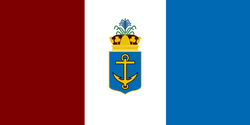 |
| Statistics |
|
| Key topics |
| Provinces |
|
Burgundie portal |
Port de Vent is part of the Burgoignesc Overseas Representative Assembly's Gran Ostiecia geographic designation. Burgoignesc Overseas Representative Assembly is a constituent country equivalent of Burgundie with its own assembly, prime minister, budget, and laws. Burgundie's national governmental influence is limited to subsidies, education, and security, however, its financial and cultural institutes cast a long shadow across Port de Vent.
Port de Vent is a province within Burgoignesc Overseas Representative Assembly with its own semi-elected Governor-Epistates, representative legislative body, and court system. Ventoises are Burgoigniacs/Burgoignix with complete civil and economic rights, and citizenship (political rights) under the same federal service criteria as all residents of Burgundie. Burgoignesc is the official language but Coscivian and Sinitalian is used in Gicupiccu and Llenguatge del vent and Lingua di l'Isule are regionally recognized both in use.
Provincial executive
The provincial executive is the Governor-Epistates. Three candidates are elected by a single transferable vote election held every 5 years, the three candidates are presented to the Court of St. Alphador and the next Governor-Epistates is chosen from these candidates. If the citizenry rejects the selection, a run-off election is held with the remaining two candidates.
Provincial legislature
Like the Citizens Court of the National Assembly (Burg. La Assemblee de Ciutadans de l'Assemblee Nacional, ACAN), The Port de Vent Citizen's Court of the Provincial Assembly is a unicameral legislator. It makes provincial law, has the power of the provincial purse, and has the power of impeachment, by which it can remove sitting members of the provincial government. The Assembly has three seats for each province, one for the Burgoignesc Overseas Representative Assembly's Port de Vent liaison, 3 for the clergy, 3 seats reserved for municipal leaders, and 3 for a rota of private business leaders. On 6 occasions throughout the year 3 more seats are opened to the public to debate topics that are not on the annual legislative agenda.
Military
Port de Vent falls under the Navy's Ostiecian Central Command, the Army of Burgundie's II Division, Foreign Legion, the Royal Air Service of Burgundie's Ostiecian Central Command, and the Vocivine National of Burgundie's Absurian Ocean Command. All of these services maintain a permanent presence on the island.
Fort St. Luc Fort Ste. Cecile
Emergency response and healthcare
Law enforcement
National Gendarmerie
Port de Vent is under the jurisdiction of the Port de Vent Regiment of the Equatorial Osteician Division of the Departmental Gendarmerie. The Port de Vent Battalion has 5 companies and an HQ section.
National Constabulary
Port de Vent is under the jurisdiction of the Port de Vent Regiment of the Equatorial Osteician Division of the Departmental Constabulary. The Port de Vent Battalion has 7 companies and an HQ section.
Revenue Guard
Port de Vent is under the jurisdiction of the Grand Station of the Odoneru of the Revenue Guard.
Healthcare
Port de Vent is serviced by 1,130 clinics, 565 pharmacies, 226 surgeries, and 4 level III hospitals, one in each island group, and two Level I trauma centers, one in Ville Port de Vent and the other in Ville Egittu on Gran Ile Capræ. Those needed a higher level of specialty care are airlifted to Equatorial Ostiecia.





